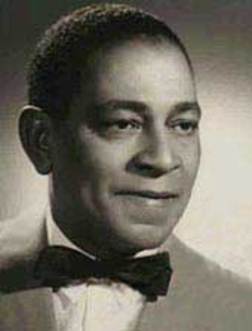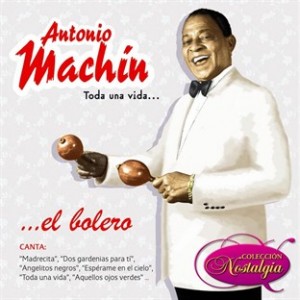Antonio Machín (Antonio Abad Lugo Machín; 11 February 1903, in Sagua la Grande, Cuba – 4 August 1977, in Madrid) was a Cuban singer and musician. His version of El Manisero, recorded in New York, 1930, with Don Azpiazú’s orchestra, was the first million record seller for a Cuban artist. Although this was labelled a rumba, it was in reality a son pregón, namely, a song based on a street-seller’s cry.
Machín was the son of a black Cuban woman, Leoncia Machín, and a white Spanish father, José Lugo Padrón, who emigrated to Cuba from Galicia. Machín, a dark mulatto, was one of sixteen children. His early years were difficult: he was forced to work at the age of eight to help pay some of his father’s numerous debts. One day, he was in the street by his house singing quietly. A priest that walked by heard him and immediately encouraged him to sing at a party. He sang Ave María by Schubert. From that day on Machin was determined to become a singer. Machín’s ambition was to sing opera, but this was difficult for a poor coloured Cuban at the beginning of the 20th century. Thus, he focused on singing popular music. At the age of twenty he had become the idol of the young women in his neighbourhood. Machín would sing them serenades under the moonlight. He worked as a mason, also travelling across Cuba as a singer. In 1926 he moved to Havana where he met a Spaniard who helped him get a contract to sing at a small café in Havana.
In Havana, Machín was exposed to many kinds of music. He joined several trios, quartets and sextets. In 1924 Machín formed a duo with the trovador Miguel Zaballa. Later he joined the Trío Luna, with Enrique Peláez and Manuel Luna. In 1926 he was brought into Don Azpiazú’s orchestra, the house band at the Havana Casino.[3] In 1930 he went to New York with Don Azpiazú’s band, where El manisero (The Peanut Vendor, written by Moises Simons) was recorded. It became the first Cuban song to become a hit in the U.S., presaging the rumba explosion of the 1930s. Machín did not return to Cuba after this tour, settling in New York for the time.
In New York, Machín recorded approximately 200 numbers, and formed the Cuarteto Machín in 1932. The other members were the Puerto Ricans Plácido Acevedo (trumpet), Cándido Vicenty (tres) and Daniel Sánchez (second voice and guitar). Machín himself was first voice. Various other musicians substituted as needed, and eventually this became the Sexteto Machín, with the great Cuban trumpeter Remberto Lara, for whom Mario Bauzá substituted on some recordings. Machín sang with other groups such as José Escarpenter y su Orquesta, Orquesta Antillana de Rafael Hernández, Julio Roque y su Orquesta, and Armando Valldespí y su Orquesta, in addition to performing with Orquesta Machín and Cuarteto Machín.
In 1935 he moved to Europe, living in London and Paris before settling in Madrid in the late 1930s, where he would remain until his death. In Paris, he formed Antonio Machín y su Orquesta, with Simons on piano, and continued to record in the city (where Cuban music had been popular since the late twenties). After moving to Madrid he married María de los Ángeles Rodríguez, from Seville, in 1943. As the Cuarteto Machín, he made over 60 recordings in Spain, often recording the works of composers Oswaldo Farrés and Consuelo Velázquez. He also had an extensive recording career singing with various Spanish bands; the total of recordings in Europe may be as many as four hundred,[4] giving him a lifetime total of about 600 numbers recorded. If that is approximately right, he would be one of the most recorded Cuban singers of the 20th century, but behind Celia Cruz.
He died in Madrid in 1977 and was buried in the San Fernando Cemetery in the city of Seville. He is best known for singing El Manisero, Dos gardenias, Madrecita, and Angelitos negros.
Sources: Wiki/InternetPhotos/youtube/www.thecubanhistory.com
Antonio Machín, singer, musician (Video)
The CUban History, Arnoldo Varona, Editor
ANTONIO MACHIN, CANTANTE, MUSICO
Antonio Machín (Antonio Abad Lugo Machín, 11 febrero de 1903, en Sagua la Grande, Cuba – 4 de agosto de 1977 en Madrid) fue un cantante y músico cubano. Su versión de El Manisero, grabado en Nueva York de 1930, con la orquesta de Don Azpiazu, fue el primer millón vendedor récord para un artista cubano. A pesar de esto se marcó como una rumba, fue en realidad un son de pregón, es decir, una canción basada en un grito de vendedor callejero.
Machín era hijo de una mujer cubana negra, Leoncia Machín, y un padre blanco español, José Lugo Padrón, que emigró a Cuba desde Galicia. Machín, un mulato oscuro, fue uno de los dieciséis hijos. Sus primeros años fueron difíciles: se vio obligado a trabajar a la edad de ocho años para ayudar a pagar algunas de las numerosas deudas de su padre. Un día, él estaba en la calle de su casa cantando en voz baja. Un sacerdote que caminaba por lo escuchó e inmediatamente le animó a cantar en una fiesta. Él cantó el Ave María de Schubert. Desde ese día Machin estaba decidido a convertirse en cantante. Machín ambición consistía en cantar ópera, pero esto era difícil para un cubano de color pobres al comienzo del siglo 20. Por lo tanto, se centró en cantar música popular. A la edad de veinte años se había convertido en el ídolo de las jóvenes de su barrio. Machín les cantan serenatas bajo la luz de la luna. Trabajaba como albañil, también viaja a través de Cuba como cantante. En 1926 se trasladó a La Habana, donde conoció a un español que le ayudó a conseguir un contrato para cantar en un pequeño café en La Habana.
En La Habana, Machín fue expuesto a muchos tipos de música. Se unió a varios tríos, cuartetos y sextetos. En 1924 Machín formó un dúo con el trovador Miguel Zaballa. Más tarde se unió a la Luna Trío, con Enrique Peláez y Manuel Luna. En 1926 entró en la orquesta de Don Azpiazu, la banda de la casa en el Casino de La Habana. [3] En 1930 se fue a Nueva York con la banda de Don Azpiazu, donde El manisero (The Peanut Vendor, escrito por Moisés Simons) se registró. Se convirtió en la primera canción cubana para convertirse en un éxito en los EE.UU., presagiando la explosión rumba de 1930. Machín no regresó a Cuba después de esta gira, estableciéndose en Nueva York para la época.
En Nueva York, Machín registró aproximadamente 200 números, y formó el Cuarteto Machín en 1932. Los otros miembros fueron los puertorriqueños Plácido Acevedo (trompeta), Cándido Vicenty (tres) y Daniel Sánchez (segunda voz y guitarra). Machín se fue primera voz. Varios músicos que lo sustituya según sea necesario, y con el tiempo esto se convirtió en el Sexteto Machín, con el gran trompetista Remberto Lara cubano, para quien Mario Bauzá sustituido en algunas grabaciones. Machín cantó con otros grupos, como José Escarpenter y su Orquesta, Orquesta Antillana de Rafael Hernández, Julio Roque y su Orquesta, y Armando Valldespí y su Orquesta, además de tocar con la Orquesta Cuarteto Machín Machín y.
En 1935 se trasladó a Europa, viviendo en Londres y París antes de instalarse en Madrid a finales de 1930, donde permanecería hasta su muerte. En París, formó Antonio Machín y su Orquesta, con Simons en el piano, y continuó grabando en la ciudad (donde la música cubana ha sido muy popular desde los años veinte). Después de trasladarse a Madrid se casó con María de los Ángeles Rodríguez, de Sevilla, en 1943. A medida que el Cuarteto Machín, hizo más de 60 grabaciones en España, a menudo grabando obras de compositores Oswaldo Farrés y Velázquez Consuelo. Él también tenía un canto de grabación extensa carrera con varios grupos españoles, el total de las grabaciones en Europa puede haber hasta 400 [4], lo que da un total de por vida de 600 números registrados. Si eso es aproximadamente correcto, él sería uno de los cantantes cubanos más grabadas del siglo 20, pero detrás de Celia Cruz.
Murió en Madrid en 1977 y fue enterrado en el cementerio de San Fernando en la ciudad de Sevilla. Él es mejor conocido por cantar El Manisero, Dos gardenias, Madrecita, Angelitos negros y.
Sources: Wiki/InternetPhotos/youtube/www.thecubanhistory.com
Antonio Machín, singer, musician (Video)
The CUban History, Arnoldo Varona, Editor



 Antonio Machín, singer, musician (Video) * Antonio Machín, Cantante, músico.
Antonio Machín, singer, musician (Video) * Antonio Machín, Cantante, músico.

